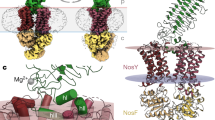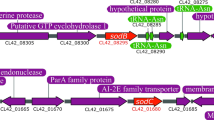Abstract
Nitric oxide (NO) is present in soil and air, and is produced by bacteria, animals and plants. Superoxide (O-2) arises in all organisms inhabiting aerobic environments. Thus, many organisms are likely to encounter peroxynitrite (OONO-), a product of NO and O-2 that forms at near diffusion-limited rates, and rapidly decomposes upon protonation through isomerization to nitrate (NO-3; ref. 1) while generating hydroxyl radical (.OH) and nitrogen dioxide radical (.NO2) (refs 2, 3), both more reactive than peroxynitrite's precursors. The oxidative, inflammatory, mutagenic and cytotoxic potential (ref. 4) of peroxynitrite contrasts with the anti-oxidant, anti-inflammatory and tissue-protective properties ascribed to NO itself5. Thus, the ability of cells to cope with peroxynitrite is central in determining the biological consequences of NO production. We considered whether cells might be equipped with enzymes to detoxify peroxynitrite. Peroxiredoxins have been identified in most genomes sequenced, but their functions are only partly understood. Here we show that the peroxiredoxin alkylhydroperoxide reductase subunit C (AhpC) from Salmonella typhimurium catalytically detoxifies peroxynitrite to nitrite fast enough to forestall the oxidation of bystander molecules such as DNA. Results are similar with peroxiredoxins from Mycobacterium tuberculosis and Helicobacter pylori. Thus, peroxynitrite reductase activity may be widespread among bacterial genera.
This is a preview of subscription content, access via your institution
Access options
Subscribe to this journal
Receive 51 print issues and online access
$199.00 per year
only $3.90 per issue
Buy this article
- Purchase on Springer Link
- Instant access to full article PDF
Prices may be subject to local taxes which are calculated during checkout




Similar content being viewed by others
References
Pfeiffer, S. et al. Metabolic fate of peroxynitrite in aqueous solution. Reaction with nitric oxide and pH-dependent decomposition to nitrite and oxygen in a 2:1 stoichiometry. J. Biol. Chem. 272, 3465–3470 (1997).
Coddington, J. W., Hurst, J. K. & Lymar, S. V. Hydroxyl radical formation during peroxynitrous acid decomposition. J. Am. Chem. Soc. 121, 2438 –2443 (1999).
Merényi, G., Lind, J., Goldstein, S. & Czapski, G. Peroxynitrous acid homolyzes into .OH and .NO2 radicals. Chem. Res. Toxicol. 11, 712– 713 (1998).
Niles, J. C., Burney, S., Singh, S. P., Wishnok, J. S. & Tannenbaum, S. R. Peroxynitrite reaction products of 3′,5′-di-O-acetyl-8-oxo-7,8-dihydro-2′-deoxyguanosine. Proc. Natl Acad. Sci. USA 96, 11729– 11734 (1999).
Wink, D. A. et al. Nitric oxide protects against cellular damage and cytotoxicity from reactive oxygen species. Proc. Natl Acad. Sci. USA 90, 9813–9817 (1993).
Jin, D.-Y. & Jeang, K.-T. in Antioxidation and Redox Regulation of Genes (eds Sen, C. K., Sies, H. & Baeuerle, P. A.) 381– 407 (Academic, New York, 2000).
Storz, G. et al. An alkyl hydroperoxide reductase induced by oxidative stress in Salmonella typhimurium and Escherichia coli: genetic characterization and cloning of ahp. J. Bacteriol. 171, 2049–2055 (1989).
Chen, L., Xie, Q. & Nathan, C. Alkyl hydroperoxide reductase subunit C (AhpC) protects bacterial and human cells against reactive nitrogen intermediates. Mol. Cell 1, 795–805 (1998).
Nathan, C. & Shiloh, M. U. Reactive oxygen and nitrogen intermediates in the relationship between mammalian hosts and microbial pathogens. Proc. Natl Acad. Sci. USA 97, 8844– 8848 (2000).
Wilson, T., de Lisle, G. W., Marcinkeviciene, J. A., Blanchard, J. S. & Collins, D. M. Antisense RNA to ahpC, an oxidative stress defence gene involved in isoniazid resistance, indicates that AhpC of Mycobacterium bovis has virulence properties. Microbiology 144, 2687– 2695 (1998).
Szabo, C., Zingarelli, B., O'Connor, M. & Salzman, A. L. DNA strand breakage, activation of poly (ADP-ribose) synthetase, and cellular energy depletion are involved in the cytotoxicity of macrophages and smooth muscle cells exposed to peroxynitrite. Proc. Natl Acad. Sci. USA 93, 1753–1758 ( 1996).
Ellis, H. R. & Poole, L. B. Roles for the two cysteine residues of AhpC in catalysis of peroxide reduction by alkyl hydroperoxide reductase from Salmonella typhimurium. Biochemistry 36 , 13349–13356 (1997).
Ellis, H. R. & Poole, L. B. Novel application of 7-chloro-4-nitrobenzo-2-oxa-1,3-diazole to identify cysteine sulfenic acid in the AhpC component of alkyl hydroperoxide reductase. Biochemistry 36, 15013– 15018 (1997).
Claiborne, A. et al. Protein-sulfenic acids: diverse roles for an unlikely player in enzyme catalysis and redox regulation. Biochemistry 38, 15407–15416 (1999).
Briviba, K., Kissner, R., Koppenol, W. H. & Sies, H. Kinetic study of the reaction of glutathione peroxidase with peroxynitrite. Chem. Res. Toxicol. 11, 1398– 1401 (1998).
Pearce, L. L., Pitt, B. R. & Peterson, J. The peroxynitrite reductase activity of cytochrome c oxidase involves a two-electron redox reaction at the heme a (3)-Cu(B) site. J. Biol. Chem. 274, 35763– 35767 (1999).
Sherman, D. R. et al. Compensatory ahpC gene expression in isoniazid-resistant Mycobacterium tuberculosis. Science 272, 1641–1643 (1996).
Yu, K. et al. Toxicity of nitrogen oxides and related oxidants on mycobacteria : M. tuberculosis is resistant to peroxynitrite anion. Tuber. Lung Dis. 79, 191–198 ( 1999).
Choi, H.-J., Kang, S. W., Yang, C.-H., Rhee, S. G. & Ryu, S.-E. Crystal structure of a novel human peroxidase enzyme at 2.0 A resolution. Nature Struct. Biol. 5, 400–406 (1998).
Becker, K., Savvides, S. N., Keese, M., Schirmer, R. H. & Karplus, P. A. Enzyme inactivation through sulfhydryl oxidation by physiologic NO-carriers. Nature Struct. Biol. 5, 267–271 (1998).
Radi, R., Beckman, J. S., Bush, K. M. & Freeman, B. A. Peroxynitrite oxidation of sulfhydryls. The cytotoxic potential of superoxide and nitric oxide. J. Biol. Chem. 266, 4244 –4250 (1991).
Beckman, J. S. & Koppenol, W. H. Nitric oxide, superoxide, and peroxynitrite: the good, the bad, and ugly. Am. J. Physiol. 271, C1424–C1437 (1996).
Go, Y. M. et al. Evidence for peroxynitrite as a signaling molecule in flow-dependent activation of c-Jun NH(2)-terminal kinase. Am. J. Physiol. 277, H1647–H1653 (1999).
Kamisaki, Y. et al. An activity in rat tissues that modifies nitrotyrosine-containing proteins. Proc. Natl Acad. Sci. USA 95, 11584–11589 (1998).
Denu, J. M. & Tanner, K. G. Specific and reversible inactivation of protein tyrosine phosphatases by hydrogen peroxide: evidence for a sulfenic acid intermediate and implications for redox regulation. Biochemistry 37, 5633–5642 ( 1998).
Koppenol, W. H., Kissner, R. & Beckman, J. S. Synthesis of peroxynitrite: to go with the flow or on solid grounds? Methods Enzymol. 269, 296–302 (1996).
Uppu, R. M. & Pryor, W. A. Biphasic synthesis of high concentrations of peroxynitrite using water-insoluble alkyl nitrite and hydrogen peroxide. Methods Enzymol. 269, 322– 329 (1996).
Poole, L. B. & Ellis, H. R. Flavin-dependent alkyl hydroperoxide reductase from Salmonella typhimurium. 1. Purification and enzymatic activities of overexpressed AhpF and AhpC proteins. Biochemistry 35, 56–64 ( 1996).
O'Toole, P. W., Logan, S. M., Kostrzynska, M., Wadstrom, T. & Trust, T. J. Isolation and biochemical and molecular analyses of a species-specific protein antigen from the gastric pathogen Helicobacter pylori. J. Bacteriol. 173, 505–513 (1991).
Acknowledgements
We thank L. Chen for generating ahpC mutations, G. St John for the H. pylori clone, H. Erdjument-Bromage and P. Tempst for protein sequencing and T. Sakmar for access to his stopped-flow spectrophotometer. This work was supported by a Norman and Rosita Winston fellowship (R.B.) and by an NIH grant (C.N.).
Author information
Authors and Affiliations
Corresponding author
Rights and permissions
About this article
Cite this article
Bryk, R., Griffin, P. & Nathan, C. Peroxynitrite reductase activity of bacterial peroxiredoxins. Nature 407, 211–215 (2000). https://doi.org/10.1038/35025109
Received:
Accepted:
Issue Date:
DOI: https://doi.org/10.1038/35025109
This article is cited by
-
Characterization of oxidative stress-induced cgahp, a gene coding for alkyl hydroperoxide reductase, from industrial importance Corynebacterium glutamicum
Biotechnology Letters (2023)
-
Types and functions of heterogeneity in mycobacteria
Nature Reviews Microbiology (2022)
-
Molecular Mechanisms of Bismuth-containing Drugs Against Helicobacter pylori: a Further Update
Current Pharmacology Reports (2022)
-
PRDX1 is essential for the viability and maintenance of reactive oxygen species in chicken DT40
Genes and Environment (2021)
-
Novel gene similar to nitrite reductase (NO forming) plays potentially important role in the latency of tuberculosis
Scientific Reports (2021)
Comments
By submitting a comment you agree to abide by our Terms and Community Guidelines. If you find something abusive or that does not comply with our terms or guidelines please flag it as inappropriate.



